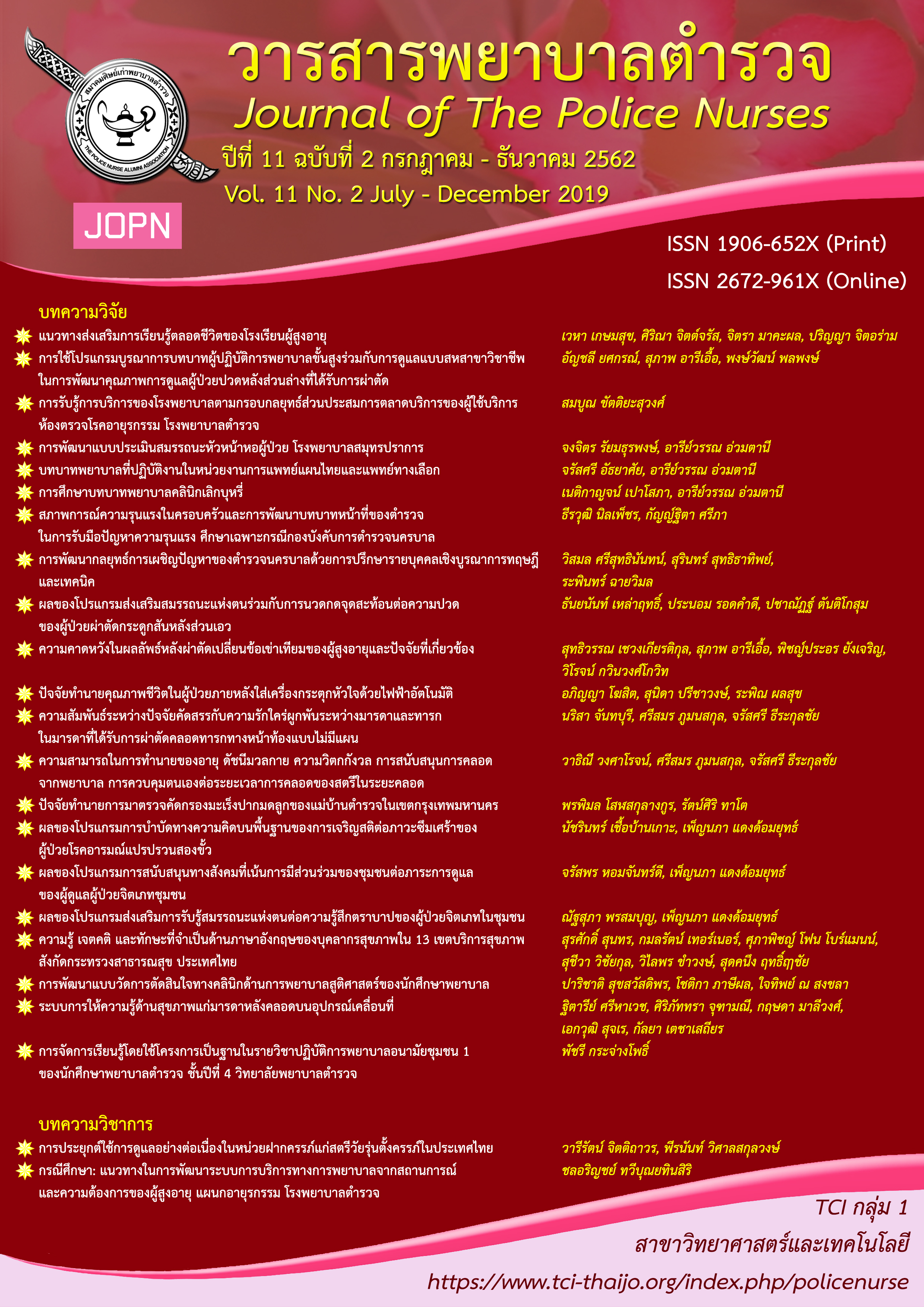THE DEVELOPMENT OF HEAD NURSES’ COMPETENCY SCALE, SAMUTPRAKARN HOSPITAL
Keywords:
competency scale, head nurse, Samutprakarn hospitalAbstract
The objectives of this study were aimed at 1) exploring the key competencies of head nurses,
2) developing a head nurses’ competency assessment scale, and 3) examining psychometric properties of the head nurses’ competency assessment scale, Samutprakarn hospital. This study was divided into three parts. Part 1 focused on studying head nurses’ key competencies by conducting focus group discussions with 26 head nurses. The data obtained were analyzed to determine the head nurses’ key competencies. Part 2 involved developing the competency assessment scale and specifying indicative behaviors in competency assessment using Rubric’s criteria. Part 3 consisted of qualified experts’ study of the head nurses’ competency scale’s quality and content validity. Reliability of assessment consistency was calculated among four assessor groups consisting of deputy head nurses, head nurses, colleagues and staff nurses (232 people).
The findings were as follows:
- The key competencies of head nurses were categorized by the following five dimensions:
1) Leadership indicating skills employed by head nurses in working to achieve goals; 2) Management perspectives showing head nurses’ capacity for effectively managing resources and service systems;
3) Information technology or head nurses’ behaviors in using information technology to benefit personnel and the organization, 4) Care quality improvement showing head nurses’ ability to promote and support the creation and implementation of innovations and nursing research to develop care service systems and 5) Morality and ethics expressed by head nurses working with responsibility, fairness and honesty while respecting and collaborating with others well. - The head nurses’ competency scale was composed of five dimensions covering the following 24 competency items including 7 leadership competency items, 6 management competency items,
2 information technology competency items, 4 care quality development items, and 5 morality and ethics competency items. - According to the psychometric properties, the scale’s CVI was .81 and reliability of assessment consistency among four groups of assessors in assessing competency among head nurses of 18 patient wards was more than .70 (100%) with a mean of .87.
Downloads
References
American Organization of Nurse Executives (AONE). (1992). The role and function of hospital nurse manager.
The Journal of Nursing Management, 23(9), 36-43.
Arechep, K. (2006). Development of a competency assessment scale of head nurses for Siriraj hospital (Master’s degree of Nursing Science). Faculty of Nursing, Chulalongkorn University.
Bureau of Nursing. (2005). Major responsibility and nurse competency document. Nonthaburi: Policy and strategy group.
Bureau of Nursing. (2006). Primary responsibilities and competencies of professional nurses. Nonthaburi: Bureau of Nursing, Department of Medical Services Ministry of Public Health.
Carroll, T. L. (2005). Leadership skill and attributes of women and nurse executives: Challenges for the 21st century. Nursing Administration Quarterly, 29(2), 146-153.
Chaipibalitsarit, P. (2008). Quality of nursing administration. Bangkok: Printing of Chulalongkorn University.
Domklang, N., & Ratchukul, S. (2008). The desirable attributes of head nurses at regional hospitals in the next decade (B.E. 2551-2560). Journal of Nursing Science Chulalongkorn University, 20(3), 16-28.
Grove, S. K., Burns, N., & Gray, J. R. (2013). The practice of nursing research: Appraisal, synthesis, and generation of evidence (7th ed). Elsevier: Saunders.
Heidi, G. A. (1997). Understanding rubrics. Educational Leadership, 54(4), 14-17.
Hospital Quality Assurance Institute (Public organization). (2015). Hospital and service standards health commemorative 60th anniversary celebrations of the throne (Revised version 2nd). Nonthaburi: D-One Books Co., Ltd.
Jermthianchai. K. (2012). Leadership with executives. Teaching Nursing Curriculum College of Nursing and Health Suan Sunandha Rajabhat University.
Leksomboonsuk, K. (2012). The components of the head nurse competency at the tertiary hospital in Suphanburi Province (Master’s degree of Nursing Science). Christian University of Thailand.
Limtrakul, D., Hinjiranan, S., & Suwonnakote, K. (2014). The components of head nurse competencies at the tertiary level hospitals in Prachuab Khiri Khan Province. Thai Journal of Nursing, 63(2):29-35.
Mertler, C. A. (2001). Designing scoring rubrics for your classroom. Practical Assessment, Research & Evaluation, 7(25), 1-9.
Nuntsuphawat, R. (1999). Nursing leadership in organization. Chiang Mai: Nop Buri Printing
Phahong, C. (1995). Factors of the head nurses’ competencies, regional medical centers and general hospitals under the jurisdiction of the Ministry of Public Health (Master’s degree of Nursing Science). Chulalongkorn University.
Phromsri, C. (2006). Top executive: Leadership. Bangkok: ExportsNet.
Phuvitthayapan, A. (2005). Competency dictionary. Bangkok: SR Center.
Pimpila, C. (2012). Development of a competency framework of head nurses, Lamphun hospital. (Master’s degree of Nursing Science). Chiangmai University.
Rattanasarn, S., & Wisesrith, W. (2008). The development of a competency assessment scale for head nurses. Thai Red Cross Nursing Journal, 1(2-3), 38-54.
Ritcharoon, P. (2019). Scoring rubrics: The tool for teachers to accurately and fairly evaluate learning outcomes. STOU Education Journal, 2(1), 1-16.
Saenprasan, P. (2006). The path to excellent nursing. Bangkok: Sukhumvit Printing.
Sirasukon, K. (2007). Rubric or rubric scoring. Bangkok: Bureau of Academic and Educational Standards.
Srisathitnarakun, B. (2008). Leadership and strategic management of nursing organizations in 21st century (2nd ed.). Bangkok: Printing of hulalongkorn University.
Sujichantrarat, R. (2003). Nursing personnel administration. Bangkok: Boonsiri Printing.
System Service Development Ministry of Public Health. (2016). Health service system development strategy health service area 6 year 2015-2017. Retrieved from http://region6.cbo.moph.go.th/ yuttha.pdf
Terdudomtham, Y. (2014). The development of head nurses’ competency assessment for Banphaeo hospital (Public organization) (Master’s degree of Nursing Science). Chulalongkorn University.
Thailand Nursing and Midwifery Council. (2013). Competency of nurse administrators. Nonthaburi:
Thailand Nursing and Midwifery Council.
Vejayanont, N. (2009). Competency model and its application in Thai organizations. Bangkok: The Grafico Systems.
Wuthirong, P. (Ed.). (2012). New tools and strategies for performance and compensation management. Bangkok: Printing of Chulalongkorn University.
Downloads
Published
How to Cite
Issue
Section
License
ผลงานที่ได้ตีพิมพ์แล้วจะเป็นลิขสิทธิ์ของวารสารพยาบาลตำรวจ



